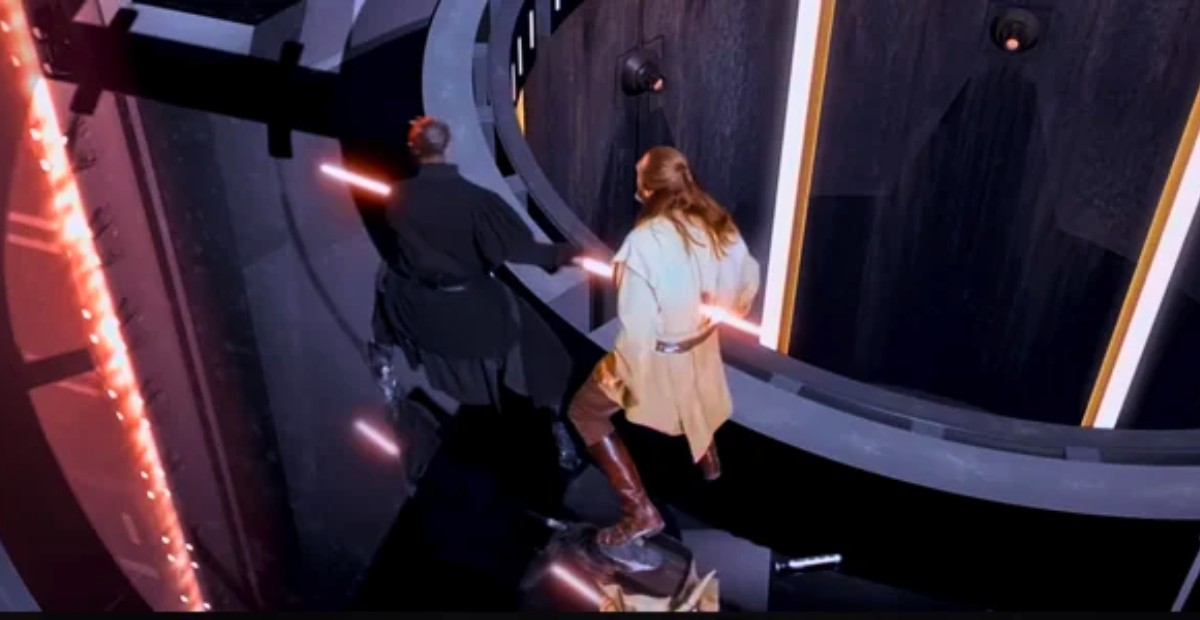There’s something about lightsaber duels that always stands out. You see two warriors clashing, sparks flying, blades humming. Then, the moment one of them falls or loses grip, the weapon shuts down in an instant. Why does that always happen?
Safety in the Galaxy
From an in-universe view, lightsabers are extremely dangerous weapons. A fully charged blade can cut through walls, floors, and pretty much anything else in its path. If one stayed on after slipping from someone’s hand, it could keep burning through everything it touched until it finally powered down. That’s why many sabers are designed with safety features. (See more: What Happens When You Drop A Lightsaber Vertically?)
Some have pressure grips that sense when the wielder isn’t holding them anymore. The instant the grip is released, the blade retracts. This is why you see examples like Qui-Gon Jinn’s saber turning off the moment he fell to Darth Maul’s strike, or Obi-Wan’s blade shutting down when General Grievous disarmed him on Utapau. It’s a built-in safeguard to prevent chaos.
Others are equipped with activation studs, buttons, or switches that need deliberate handling. A few even have locking mechanisms, which let the blade stay ignited when thrown.
But in most cases, unless the Jedi or Sith specifically modified their weapon, a dropped saber would deactivate instantly. It’s simple protection against accidents in a galaxy where technology often doubles as a death trap.
Symbolism in the Story (Lucas BTS)
Behind the camera, lightsabers turning off is just as much about storytelling. George Lucas himself once said in a meeting when asked the same question, “I don’t care. Lightsabers do whatever we need them to do.” And that’s the real secret—lightsabers aren’t bound by strict rules. They behave in ways that serve the story.
When a warrior falls and their blade dies with them, it sends a powerful message. The saber isn’t just a weapon—it’s a symbol of the wielder’s life and strength. Seeing the glow vanish the moment its master is defeated creates closure for the scene. It marks the end of their struggle in a way that audiences can feel instantly, without a word spoken.
That’s why even though the galaxy offers technical explanations, the deeper reason lies in cinematic symbolism. A fading blade mirrors a fading life, and that connection is far more dramatic than leaving a rogue saber buzzing away in the corner.
The Creative Side of Star Wars
The truth is, much of Star Wars was built on fast decisions and creative instincts rather than rigid rules. As one former Lucasfilm worker shared, George Lucas didn’t worry about explaining how lightsabers worked in detail—he trusted that fans would piece it together. And they did. Over the years, audiences came up with countless theories to explain the quirks of lightsaber behavior, filling in the gaps the films left open.
What started as a practical filmmaking choice—“turn off the glowing prop when it’s no longer needed”—evolved into a rich part of the lore. Fans turned safety grips, activation studs, and mechanical features into canon details, making sense of moments where sabers switched off by themselves.

